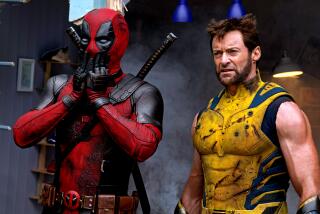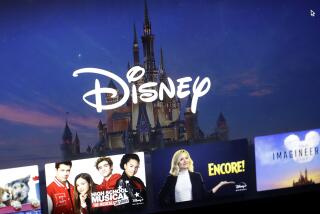Soundtrack Firm Gets Big Break in the Movies : Film: ‘Jurassic Park’ opened the door. Steven Spielberg and Universal Studios own stakes in Digital Theater Systems of Westlake Village.
- Share via
WESTLAKE VILLAGE — To start a new business in the closed, clubby world of Hollywood, you need money and connections. When Terry Beard developed a new digital sound format for movies he had both.
Beard, a Caltech-trained engineer who spent 20 years inventing much of the stereo optical recording equipment used in movie production, opened a new company in Westlake Village called Digital Theater Systems (DTS).
A friend of Beard’s was a friend of director Steven Spielberg, and they arranged a demonstration of DTS. As Spielberg watched and listened to scenes of his “Close Encounters of the Third Kind” in DTS, he was converted. “I was flabbergasted,” Spielberg said, and recalls switching back and forth from the traditional soundtrack to DTS. “It (DTS) sounded exactly like 70 millimeter six-track sound.”
But Spielberg worried about one thing: the DTS’ format stores the movie digital soundtrack on a separate compact disc. If the disc became separated from the film, or failed, would his movie become a silent film? DTS argued that its system was fail-safe; if the digital soundtrack didn’t work, the traditional analog sound track would kick in.
As Spielberg prepared the release of “Jurassic Park,” the director told Universal Studios he wanted the soundtrack of his blockbuster-to-be in DTS. So Universal bought $4 million worth of DTS hardware to equip 1,000 theaters for the digital sound version of “Jurassic Park.”
It was DTS’ big break. The dinosaur epic lent credibility to the format, and in July, Spielberg bought a minority stake in Digital Theater Systems, as did Universal Studios. Universal, and Spielberg’s production company Amblin Entertainment, soon committed to release all their pictures in DTS. Spielberg’s current film, “Schindler’s List,” is also using the format.
Now, Beard, who is president of DTS, is competing with Dolby Laboratories Inc. and Sony to emerge as the dominant digital sound system for movie theaters.
Since 1992, Dolby, based in San Francisco, has been marketing its Dolby Stereo Digital sound for movies. Sony, parent of Columbia Pictures, TriStar and Sony Pictures Classics, is also competing with its Sony Dynamic Digital Sound.
Dolby said there’s little difference in the sound quality between itself and DTS. But it believes the presence of its digital soundtrack on the film print, rather than on a separate disc, is an advantage. “There have been many examples of film technology in the past, such as the early talkies, where film and sound were on separate components. They can become separated,” said Joe Hull, a Dolby spokesman.
However, DTS claims that its system is safe, and that by using CDs for sound, studios will save money when they dub their films for overseas markets, rather than having to have another film print made.
Spielberg emphasized that the final decision to use DTS is up to a film’s director. Spielberg does occasionally demonstrate it to director friends. “DTS sells itself,” said Spielberg.
With the backing of Spielberg and Universal, DTS has pulled ahead of its competitors. By the first week of January, DTS’ digital sound equipment will be in 2,000 theaters worldwide, according to the company. That’s compared to Dolby Stereo Digital’s presence in 500 theaters worldwide. Sony won’t officially be in the marketplace until spring 1994, but it’s been testing its prototypes for months.
Most of DTS’ sound systems so far have been installed in North America, where there are 25,000 movie screens; worldwide there are about 50,000 movie screens.
Studio and movie theater executives believe only one digital movie sound format will prevail and they predict a shakeout within two years. Exhibitors don’t want to buy multiple pieces of equipment, so many are holding back to see which format becomes the standard.
“We’re all searching for efficiency. This smorgasbord isn’t acceptable,” said Greg Rutkowski, vice president of western operation for AMC Theaters, the Kansas City, Mo.-based theater chain.
“Our philosophy is that digital sound and DTS will be the standard release format,” said Bill Neighbors, DTS’ vice president and general manager.
Like the compact discs people listen to at home, digital movie soundtracks offer crystal clear tones delivered with the help of computer technology. Since CDs are impervious to wear and tear, the soundtrack doesn’t have the hisses and pops associated with traditional movie sound.
With DTS’ six-channel system, the film carries a time code to keep the soundtrack in sync with the movie. Should the coding fail, the system is programmed to return to the traditional soundtrack, which is on the film. So far, DTS has had only a few instances in which the digital sound has cut out briefly, according to Neighbors.
*
Neighbors estimates that DTS will post sales of $6 million for the 10 months ending Dec. 31. Next year, Neighbors expects sales to climb to $10 million.
DTS makes its money from two sources. Studios pay a license fee for the digital sound service--as much as $7,500 per movie--plus $100 for two CDs for each film print (each movie uses two discs). Movie theaters also buy the DTS hardware through a network of dealers. The hardware has a list price of $5,950 per screen, but few exhibitors pay the full amount.
One of DTS’ big appeals to theater owners is that its hardware costs half to one-third Dolby’s rate. Sony will sell its digital sound hardware equipment for theaters at a list price of $13,800.
Even without its competitors, DTS must overcome bad memories left by the digital movie sound pioneer. In 1990, now-defunct Optical Radiation Corp. put its digital sound format on Walt Disney Co.’s “Dick Tracy” and Paramount Pictures’ “Days of Thunder,” plus a few other films. There were a few well-publicized incidents in which that digital soundtrack failed. And because there was no backup, the movies went silent.
Once burned, Hollywood studios have been reluctant to sign on with another digital sound format. When DTS’ Neighbors first approached Paramount Pictures, for example, he was literally ordered off the lot by studio Senior Vice President Paul Haggar.
But movie director Steve Kloves, who did “The Fabulous Baker Boys,” saw a DTS presentation and liked it. So he pushed to use it in his Paramount film, “Flesh and Bone.” Kloves had to overcome Haggar’s reticence. But he eventually got his way.
So far, Paramount is approaching this on a picture-by-picture basis. “I like the digital sound system on ‘Flesh and Bone,’ ” said Haggar. “But that doesn’t mean we won’t use Dolby in the future.”
Warner Bros. also agreed to release a film with DTS, “On Deadly Ground,” a Steven Seagal action film opening in February.
New Line Cinema has signed on to release six pictures using the DTS process. “DTS seems to be trouble-free and it’s relatively inexpensive for exhibitors,” said Mitch Goldman, New Line president of marketing and distribution. “It’s a marketing tool for us.”
Studio executives and theater owners believe all movie theaters will eventually convert to one of the digital sound systems. DTS has already started to introduce its service in Europe, where it’s aiming to find acceptance among the 70% to 80% of the estimated 15,000 screens there that use a stereo sound system. It has also established a presence in Australia, Japan, Israel and Turkey. Dolby has been marketing its digital sound system internationally from the start.
“We are winning the race, but this is a marathon,” DTS’ Neighbors said. “We’re playing against some very powerful competitors.”
More to Read
The biggest entertainment stories
Get our big stories about Hollywood, film, television, music, arts, culture and more right in your inbox as soon as they publish.
You may occasionally receive promotional content from the Los Angeles Times.










